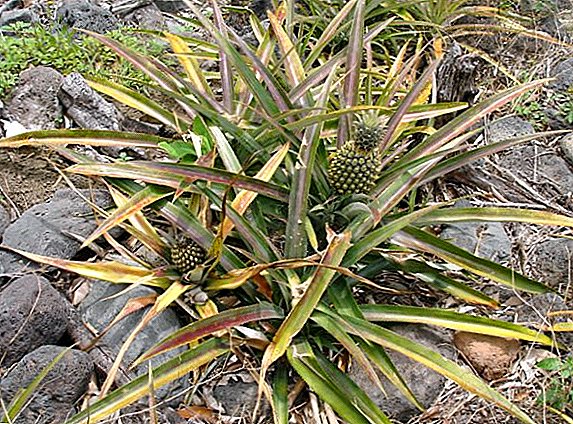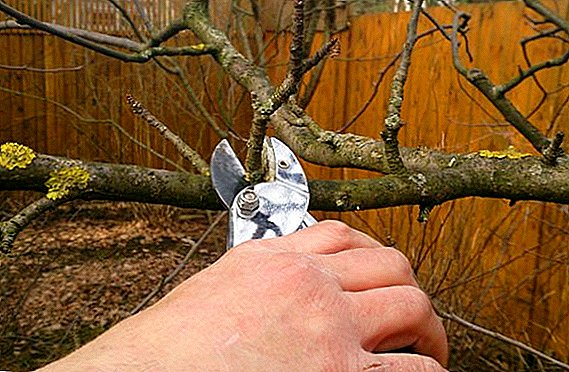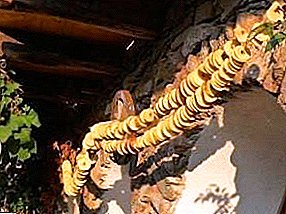
Among the varieties of potatoes, popular with amateur gardeners, a special place is occupied by "Sineglazka". The grade has received the name for the unusual, remembered coloring of tubers. Other qualities deserve attention: yield, excellent taste of root crops, resistance to diseases.
In the article you will find all the information about the potato "Sineglazka", description of the variety, photos and a lot of useful, and most importantly interesting information.
Variety description
| Grade name | Blue-eyed |
| general characteristics | variety of amateur breeding, high-yielding with good taste, but poor keeping quality |
| Gestation period | 65-80 days |
| Starch content | 15% |
| Mass of commercial tubers | 70-130 gr |
| The number of tubers in the bush | 8-12 |
| Yield | up to 500 kg / ha |
| Consumer quality | great taste, suitable for any dishes |
| Recumbency | about 75% rotting when storing large quantities |
| Skin color | cream |
| Pulp color | white |
| Preferred growing regions | Variety zoned for central Russia |
| Disease resistance | average resistant to all diseases of the nightshade |
| Features of growing | standard agricultural technology |
| Originator | launched in the 50s of the last century by S. Domin at the Institute of Starch Products; recognized as unpromising |
"Sineglazka" - mid-season variety with early onset of tuberization. Ideal for private household farms, in industrial quantities almost never grown. How to grow early potatoes correctly read here.
Description of root:
- tubers are large, weighing from 150 to 200 g;
- oval shape, slightly flattened;
- the rind is pink-gray with a bluish tinge;
- eyes superficial, few, dark blue;
- the pulp on the cut is white;
- average starch content, up to 15.5%;
- high protein, mineral salts, vitamins of group B.
In the table below you will find data on the content of starch in different varieties of potatoes:
| Grade name | Starch content |
| Blue-eyed | 15% |
| Manifesto | 11-15% |
| Tiras | 10-15% |
| Elizabeth | 13-14% |
| Vega | 10-16% |
| Lugovskoy | 12-19% |
| Romano | 14-17% |
| Santa | 10-14% |
| Tuleyevsky | 14-16% |
| Gypsy | 12-14% |
| Fairy tale | 14-17% |
A photo
Now that you have already received some ideas about the Sineglazka potato variety, the characteristics of its appearance, the root crop, let's turn to the photos:


Regions of breeding and growing
Variety zoned for central Russia, successfully grown in other regions. Productivity is high, up to 500 kg. per hundred. The quality of the crop depends on the planting material, weather conditions and the nutritional value of the soil.
Compare the yield of this variety with others, you can refer to the table below:
| Grade name | Yield |
| Blue-eyed | up to 500 kg / ha |
| Kubanka | up to 220 kg / ha |
| Felox | 550-600 c / ha |
| Pretty boy | 170-280 kg / ha |
| Red scarlett | up to 400 kg / ha |
| Borovichok | 200-250 centners / ha |
| Bullfinch | 180-270 c / ha |
| Kamensky | 500-550 c / ha |
| Colomba | 220-420 c / ha |
| Spring | 270-380 c / ha |
The bush of the potato "Sineglazka" is large, powerful, with strong stems and a developed root system. Abundant formation of green mass. The leaves are medium sized, dark green. Flowers light blue, small.
Potatoes are characterized by early tuber formation and extended vegetation period. The first harvest can be collected in June, the end of the harvest - the end of September. The variety prefers a light sandy soil with neutral acidity, in heavy, poor soil yield is reduced.
 Watering moderate, no more than 5 times per season. "Sineglazka" prefers nourishing soilMandatory root dressing with mineral complexes or organic fertilizers. About when and how to make feeding and how to do it when planting potatoes, read the individual articles of our website.
Watering moderate, no more than 5 times per season. "Sineglazka" prefers nourishing soilMandatory root dressing with mineral complexes or organic fertilizers. About when and how to make feeding and how to do it when planting potatoes, read the individual articles of our website.
The variety is resistant to typical diseases: potato cancer, late blight, scab, nematode, viral infections. Strong tubers are not damaged when digging. Small volumes are kept well, but the variety is not suitable for industrial cultivation.
About the conditions in which to store potatoes in the winter, what place to choose for this and what time it is necessary to meet, read in the detailed materials of our site.
"Sineglazka" is loved by gardeners for its excellent taste. The potato is ideal for boiling, roasting and mashing, it is crumbly, very tender, with a pleasant rich flavor. Boiled tubers have a beautiful white and cream color. Potatoes are easily digested and can be recommended for baby or diet food.
We have prepared for you several useful articles on how to properly store peeled potatoes and whether it is possible to keep the benefits of this product in the refrigerator.
Origin
Potatoes variety "Sineglazka" - hybrid of several forms of cultivated potato with wild growing. Bred by breeder S. Demin in the late 1940s, registered at the Institute of Starch Products under the number 15555.
The hybrid was tested at several experimental stations, was highly appreciated by specialists and recommended for growing in private farms. Tests on industrial cultivation "Sineglazki" were less successful. Large volumes of harvested potatoes were poorly stored, the tubers quickly lost their presentation.
Advantages and disadvantages
Among the main advantages of varieties noted:
- high taste of root vegetables;
- wide culinary possibilities (boiling, stewing, baking, mashing is possible);
- resistance to major diseases;
- beautiful appearance of root crops;
- thin skin, a small number of eyes.
Among the shortcomings of the variety noted:
- the possibility of degeneration of planting material;
- large volumes of harvested potatoes poorly stored;
- tubers can be damaged by the wireworm.
Features
"Sineglazka" refers to the old varieties, which have a number of features. In a favorable year (warm weather, sufficient, but not excessive amount of rain, the minimum number of pests) potatoes show high yields, the tubers are large, smooth, intact. The deterioration of weather conditions greatly reduces the yield, the tubers are shrinking.
Good results are obtained by growing potatoes from seeds.This makes it possible to update the planting material without additional costs for its purchase. Potatoes are responsive to feeding. It does not hurt and mulch beds.
Fertilize plants directly after watering, 3-4 times per season. For feeding, rotted manure or diluted bird droppings are used. Organics can be alternated with a mineral complex, including ammonium nitrate, superphosphate or ammonium sulfate.
 In addition to fertilizers in the cultivation of potatoes use a variety of tools and drugs. Disputes about their benefits is a lot.
In addition to fertilizers in the cultivation of potatoes use a variety of tools and drugs. Disputes about their benefits is a lot.We bring to your attention detailed articles about how and why herbicides, fungicides and insecticides are used.
Harvest can be collected from the beginning of summer to September, but the best quality tubers are gaining by August. After digging, the tubers are dried for at least 3 hours. In cloudy weather, drying is carried out in a shelter or under a canopy.
The greater the harvest, the more carefully dried tubers. The variety is characterized by poor keeping quality, for potatoes a spacious dry cellar is needed. Tubers are folded in boxes. Potatoes should be picked regularly, discarding rotten or infected tubers.
Diseases and pests
Sort "Sineglazka" has good immunity. However, only updated varietal material is different in resistance to nematode, scab, or late blight. Potatoes grown on amateur sites gradually degenerate and become vulnerable to viruses. As a preventive measure, timely updating of planting material is necessary.
Potatoes can be affected by Colorado potato beetles damaging tops. Beetles are very harmful. Their larvae damage the tubers, making them unsuitable for feeding, open access to viruses and bacteria, they must be fought.
To avoid damage to the crop, potatoes are planted only on the soil, pre-treated with chemicals. After harvesting, it is necessary to select all tubers from the ground. Left for the winter root crops decompose, creating a breeding ground for bacteria and attracting insects.
This potato variety has remained popular for many years. With proper selection of planting material and fertile soils, you can consistently receive a good harvest. Harvested potatoes need careful storage and frequent bulkheads.
We hope that with the help of the above information about the Sineglazka potato, a description of its advantages and disadvantages, it will be easier for you to decide whether to grow them.
We also suggest that you familiarize yourself with potato varieties that have different ripening terms:
| Middle late | Medium early | Mid-season |
| Vector | Gingerbread Man | Giant |
| Mozart | Fairy tale | Tuscany |
| Sifra | Ilinsky | Yanka |
| Dolphin | Lugovskoy | Purple Haze |
| Crane | Santa | Openwork |
| Rogneda | Ivan da Shura | Desiree |
| Lasock | Colombo | Santana | Aurora | Manifesto | Typhoon | Skarb | Innovator | Alvar | Magician | Crown | Breeze |












